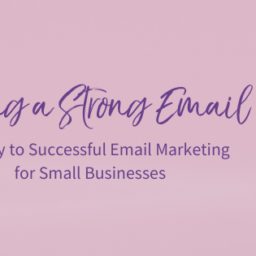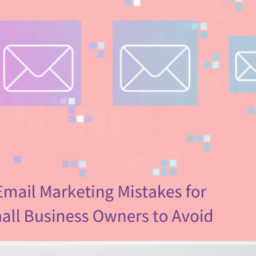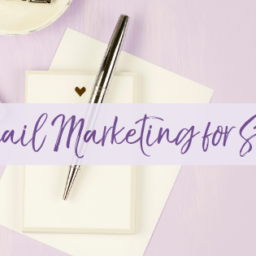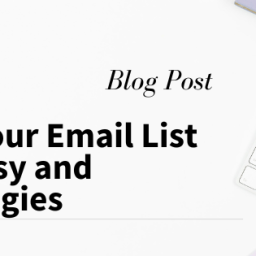
As a small business owner, it can be challenging to craft the perfect email campaign. There’s design, the content, and the subject line to think about – all these elements can significantly impact your campaign’s success. So, how can you ensure that you’re making the right choices? Well, the answer lies in A/B Testing.
Let’s take a look at how A/B testing can be your secret weapon to optimise your email campaigns.
What is A/B Testing?
A/B testing, also known as split testing, is a method of comparing two versions of an email, a landing page, and subject lines for example to see which one performs better. It’s like conducting a little science experiment right in your email marketing platform!
The idea is you send out two versions of your email campaign to a small portion of your subscribers. One group receives version A (known as the control), and the other receives version B (the variant). The version that gets the most opens, clicks, or conversions, depending on your goal, is the winner.
Why You Should Be A/B Testing Your Emails
A/B testing is not just a fancy technique used by big businesses. It’s a powerful tool that every small business owner should be using. Why? Because it takes the guesswork out of your email marketing.
The benefit of A/B testing allows business owners to be more informed and use data to make their business more optimised and efficient in their marketing efforts. By A/B testing your emails, you can make data-driven decisions about your email campaigns. You can find out what type of content resonates with your audience, what subject lines get the most opens, and what call-to-actions drive the most clicks.
How to Conduct an A/B Test
Now that we’ve established the importance of A/B testing let’s walk through how to conduct one.
- Identify Your Goal: What do you want to achieve with your email campaign? More opens, clicks or conversions? This goal will guide your A/B test.
- Choose Your Variable: Decide on the element you want to test. It could be the subject line, the email content, the call-to-action, or even the email design.
- Create Your A and B Versions: Make sure the only difference between the two versions is the variable you’re testing.
- Send Your Emails: Use your email marketing platform to send version A to one group of subscribers and version B to another.
- Analyse the Results: After a set period, analyse the results. Which version met your goal better?
A/B Testing Best Practices
A/B testing can give you valuable insights, but only if done right. Here are some best practices to keep in mind:
Test One Variable at a Time: If you change multiple elements, you won’t know which one caused the difference in performance.
Use a Large Enough Sample Size: The more people you test, the more reliable your results will be, remember to make sure your sample sections are of equal size.
Give Your Test Enough Time: Don’t rush to conclusions. Give your test enough time to collect significant data, you may need to repeat it.
Wrapping Up
Remember, A/B testing is not a one-and-done deal. It’s a continuous process of testing, learning, and optimising. As your business evolves, so will your audience’s preferences. Keep testing, keep tweaking, and you’ll continue to see improvements in your marketing campaigns.
And there you have it – your guide to A/B Testing. So, are you ready to start optimising your email campaigns? If you need any help, don’t hesitate to reach out. I’m here to support you in your email marketing journey!
Remember: A/B Testing is the secret sauce to optimising your email campaigns. Start using it today to make data-driven decisions and boost your email marketing performance.
frequently asked questions about a/b testing
- What exactly is A/B testing in email marketing?
A/B testing in email marketing is a method where you compare two different versions of an email to determine which one performs better in terms of open rates, click-through rates, conversions, and other key metrics.
- How can A/B testing benefit my small business?
A/B testing can benefit your small business by providing valuable insights into what resonates with your audience. By testing different elements such as subject lines, call-to-action buttons, or content variations, you can optimize your emails for higher engagement and conversion rates.
- Can you give me a step-by-step guide on how to conduct an A/B test for my email campaign?
Here’s a step-by-step guide on conducting an A/B test for your email campaign:
– Identify the element you want to test (e.g., subject line).
– Split your subscriber list into two equal segments.
– Create two versions of the same email with only one differing element.
– Send version A to segment 1 and version B to segment 2.
– Monitor the performance of each version using relevant metrics.
– Determine the winning version based on desired goals (e.g., higher open rate) and send it to the remaining subscribers.
- How do I decide which aspects of my email to test using A/B testing?
When deciding which aspects of your email to test using A/B testing, focus on variables that significantly impact engagement or conversions. These could include subject lines, preheaders, sender names, personalization techniques, and images versus text-based content formats.
- How long should I run an A/B test for reliable results?
The duration of an A/B test depends on factors like audience size and desired statistical significance level. Generally speaking though if you have large enough sample sizes running tests for at least three days should give reliable results.
- Why should I only test one variable at a time during A/B testing?
It’s crucial to test only one variable at a time during A/B testing because this allows you to isolate its impact accurately without any interference from other changes made within the same experiment.
- How large should my sample size be for A/B testing?
The ideal sample size for A/B testing depends on various factors such as expected effect size or minimum detectable effect but generally having a larger sample size provides more accurate results with smaller margins of error.
- Can A/B testing help me understand what type of content resonates with my audience?
Absolutely! A/B testing can help you understand what type of content resonates with your audience. By experimenting with different formats, tones, or topics, you can gather insights on their preferences and tailor your future email campaigns accordingly.
- Is A/B testing a one-time process or should it be done continuously?
A/B testing should be done continuously as consumer behaviour and market dynamics evolve over time. Regularly evaluating the performance of your emails through A/B tests allows you to stay ahead of the curve and consistently optimize your marketing efforts.
- How can A/B testing optimise my email campaigns and improve my marketing performance?
A/B testing optimises your email campaigns by providing data-driven insights into what works best for your audience. It helps identify effective strategies that improve open rates, click-through rates, conversions, and overall marketing performance. By implementing these findings in future campaigns, you can enhance engagement levels and drive better results for your small business.











